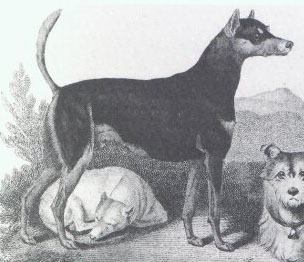Breed History/Purpose
 The Manchester Terrier is one of the
oldest breeds of Terriers currently recognized by the Canadian Kennel
Club. Dr. Caius' "Encyclopedia of Dogs," published in 1570,
mentions the Black and Tan Terrier -- the forerunner to the modern day
Manchester. Though rougher in coat and shorter on leg than today's
Manchester Terrier, the Black and Tan did possess a keen ratting ability which
made it attractive to blood sport and rabbit coursing enthusiasts alike.
One fancier in particular, Mr. John Hulme, crossed a Whippet with a cross-bred
terrier to combine both sports into one breed. The cross was so successful
that it was repeated, resulting in the establishment of a specific type.
The Manchester Terrier is one of the
oldest breeds of Terriers currently recognized by the Canadian Kennel
Club. Dr. Caius' "Encyclopedia of Dogs," published in 1570,
mentions the Black and Tan Terrier -- the forerunner to the modern day
Manchester. Though rougher in coat and shorter on leg than today's
Manchester Terrier, the Black and Tan did possess a keen ratting ability which
made it attractive to blood sport and rabbit coursing enthusiasts alike.
One fancier in particular, Mr. John Hulme, crossed a Whippet with a cross-bred
terrier to combine both sports into one breed. The cross was so successful
that it was repeated, resulting in the establishment of a specific type.
Originally bred as a
"ratting machine" Manchester's made frequent and highly acclaimed
appearances in the rat pits. By the mid-1800's the breed was
becoming more defined and in 1827 "Billy" (a dog generally believed to
be of Manchester-type) was reported to have killed 100 rats in 12 minutes.
Not to be outdone, "Tiny the Wonder," a 5 1/2 pounder, killed 300 rats
in 54 minutes, 53 seconds during a highly publicized contest at the Queen's
Hotel in London in 1848. As a result of their popularity in the rat pits
the ears were generally cropped to guard against being torn by their feisty
prey. This also served to enhance the sharp appearance of the expression.

By 1860 the name Manchester Terrier surfaced
as the community of Manchester was now recognized as the center of development
for the breed. When blood sports became illegal in England the Manchester
moved out of the limelight and into the taverns and farming communities of
England where they continued to serve a much needed purpose.
During the late 19th century the popularity of the breed
fell with the outlawing of blood sports and the banning of ear cropping.
It was at this point that several devoted breeders began to reform the breed. By
using a Whippet cross they were able to transform the breed from the rough
coated, rugged terrier of the ratters to the sleek, elegant, gentleman's
companion we now know.
About this time the popularity of smaller specimens began to grow and,
true to Victorian fashion, tiny Manchester's became all of the rage. It is
generally thought that unethical persons introduced the Chihuahua in order to
diminish size even further and astonishingly the Manchester Terrier was soon
appearing in sizes as small as 2 1/2 pounds!!! As a result of this
careless breeding the smaller specimens became frail and sickly.
In Canada the Manchester Terrier was first
registered in 1888-89 when 6 Toy Manchester Terriers and 20 Manchester Terriers
were registered in the stud books. Over the ensuing years a variety of
factors would shape the continued evolution of this breed. By midway
through the 20th century the Standard Manchester Terrier faced serious
population depletions and turned to the Toy variety for help. Intervariety
(Toy X Standard) breeding soon became the norm in order to increase the
population as well as to address difficulties Toy breeders faced due to the
miniaturization of the breed.
The Manchester now appears as two varieties
in North America, distinguished primarily by weight: Toys up to, but not
exceeding 12 lb., and Standards 12-22 lb. Even today intervariety
breeding is permitted in both Canada and the United States. It is
important to note, however, that European and Australian Manchester Terriers
remain completely differentiated. The Toy Manchester in these countries is
known as the English Toy Terrier and differences between European & American
examples are notable and varied. Any person judging or observing in these
countries should consult the breed standard specific to that country and not rely
completely on knowledge of North American standards.
Points to Remember:
 The Manchester Terrier is one of the
oldest breeds of Terriers currently recognized by the Canadian Kennel
Club. Dr. Caius' "Encyclopedia of Dogs," published in 1570,
mentions the Black and Tan Terrier -- the forerunner to the modern day
Manchester. Though rougher in coat and shorter on leg than today's
Manchester Terrier, the Black and Tan did possess a keen ratting ability which
made it attractive to blood sport and rabbit coursing enthusiasts alike.
One fancier in particular, Mr. John Hulme, crossed a Whippet with a cross-bred
terrier to combine both sports into one breed. The cross was so successful
that it was repeated, resulting in the establishment of a specific type.
The Manchester Terrier is one of the
oldest breeds of Terriers currently recognized by the Canadian Kennel
Club. Dr. Caius' "Encyclopedia of Dogs," published in 1570,
mentions the Black and Tan Terrier -- the forerunner to the modern day
Manchester. Though rougher in coat and shorter on leg than today's
Manchester Terrier, the Black and Tan did possess a keen ratting ability which
made it attractive to blood sport and rabbit coursing enthusiasts alike.
One fancier in particular, Mr. John Hulme, crossed a Whippet with a cross-bred
terrier to combine both sports into one breed. The cross was so successful
that it was repeated, resulting in the establishment of a specific type.

